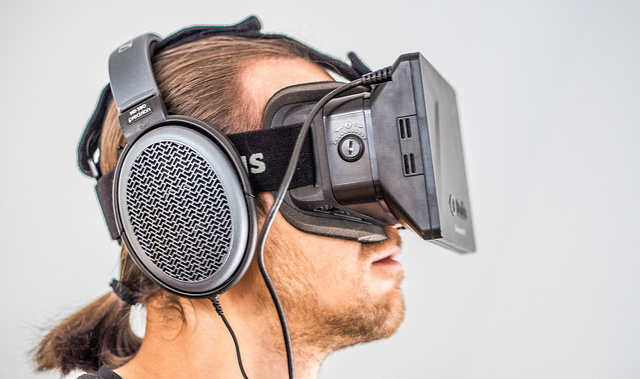VR: A New Frontier in User Experience
The market for VR as a form of consumer electronics is set to be potentially gigantic; particularly in 2016 when the Oculus Rift, one of the most popular iterations of VR technology, goes on general sale. The last sizable shake-up of how consumers interacted with technology was with the advent of touch screens in smartphones and tablet, and even this presented users with the same forms of communicative experiences; looking at a screen and inputting commands through external hardware.
With a new digital market set to expand, VR has the potential to transform how user experiences and interfaces are designed. Previously, designers and developers account for the traditional ways in which people communicate with technology, but with a lack of quantifiable understanding of VR technology at present, it is highly possible that the ways we approach UI, UX, web development and consumer technologies are set to alter drastically.

Human Interaction
One of the most significant changes will be how developers approach the task of constructing digital products for VR use, such as websites and applications. People will naturally interact with websites differently, from both a UX perspective and how they physically control the interactive aspects of a site. The user experience can be the make-or-break issue for users when they visit a site or use an app, but designing for new means of human interaction will be an important part of the success of VR technologies.
Oculus has already confirmed that the Rift will be an open source platform, meaning anyone is open to develop for the platform and access the source code and technologies which make it work. This is the same approach Google have taken to their mobile technologies to maintain the Open Handset Alliance and its flagship Android software, resulting in new user experiences which took advantage of smartphone technologies. At the time, this constituted a starkly different way of interacting with technology and slowly altered many aspects of web development and eCommerce, such as accessibility.
VR is set to raise the bar even further, allowing for users to interact with technology without traditional forms of input such as a mouse or keyboard. This represents a significant shift from the well-established ways of how user experiences have been developed for traditional consumer technologies. Users can now interact with an interface through movements of the head and hand gestures; natural movements of the body which are now becoming an integral part of our interaction with digital interfaces.
Microsoft demonstrates its Hololens VR technology at E3 2015. Via GameSpot
The Evolution of UX Development
For those who use technology on a daily basis, think about how this will change your well-ingrained daily digital routines. It could be checking your phone or tablet and browsing social media channels, or using your desktop to browse emails and watch videos. The arrival of potentially well-established VR platforms could change this interaction in a far more drastic way than the advent of mobile technologies.
Before any of this can be accomplished, the first step is research and development. There’s no factual data regarding how people will use these platforms yet, and it’s unknown whether or not they have the potential to grow in the same way the mobile market has; this will be based on how appealing the user experience ultimately is. For developers, there’s going to be a whole lot more to take into consideration when designing for the VR user experience.
Instead of looking at a screen, and to a lesser extend our keyboards, monitors and other external sources, VR will account for the entirety of our visual perception and interaction. Our perception of this sensory experience is currently grounded completely in reality, as no computer interface has yet required complete control over our sight, and subsequently many of our reactionary sense such as balance and reflexes. This marks perhaps the biggest departure from what could soon call ‘traditional’ forms of computer interaction.
The Near Future
UX is typically developed within a laboratory setting and evaluated under strict testing conditions which define a variety of test scenarios. With VR, UX research can benefit greatly from a more directly applied form of testing, in which limitations and methods are clearly presented and observable within a context of human interaction. Taking advantage of these more malleable testing environments will allow for a greater acceleration in UX development within VR technologies, ultimately bringing us closer to embracing entirely new forms of computer interaction.
Thanks for Reading
Take a look at some of our other blog posts to find out more about digital trends, or sign up to the ThoughtShift Guest List, our monthly email, to keep up-to-date on all our blogposts, guides and events.
